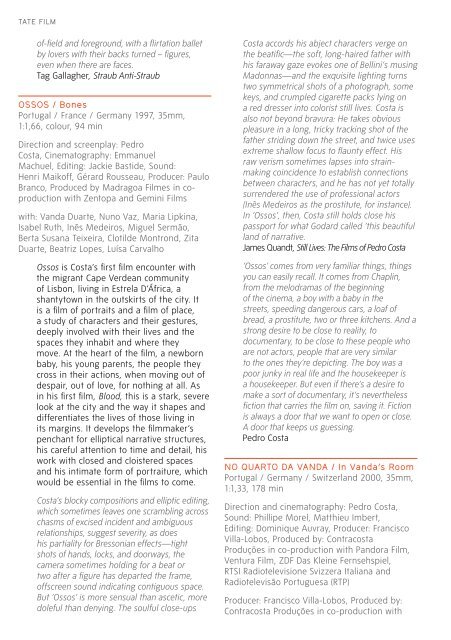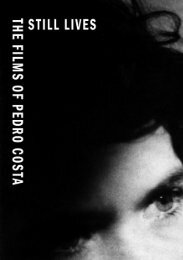You also want an ePaper? Increase the reach of your titles
YUMPU automatically turns print PDFs into web optimized ePapers that Google loves.
<strong>TATE</strong> FILM<br />
of-field and foreground, with a flirtation ballet<br />
by lovers with their backs turned – figures,<br />
even when there are faces.<br />
Tag Gallagher, Straub Anti-Straub<br />
OSSOS / Bones<br />
Portugal / France / Germany 1997, 35mm,<br />
1:1,66, colour, 94 min<br />
Direction and screenplay: Pedro<br />
Costa, Cinematography: Emmanuel<br />
Machuel, Editing: Jackie Bastide, Sound:<br />
Henri Maikoff, Gérard Rousseau, Producer: Paulo<br />
Branco, Produced by Madragoa Filmes in coproduction<br />
with Zentopa and Gemini Films<br />
with: Vanda Duarte, Nuno Vaz, Maria Lipkina,<br />
Isabel Ruth, Inês Medeiros, Miguel Sermão,<br />
Berta Susana Teixeira, Clotilde Montrond, Zita<br />
Duarte, Beatriz Lopes, Luísa Carvalho<br />
Ossos is Costa’s first film encounter with<br />
the migrant Cape Verdean community<br />
of Lisbon, living in Estrela D’África, a<br />
shantytown in the outskirts of the city. It<br />
is a film of portraits and a film of place,<br />
a study of characters and their gestures,<br />
deeply involved with their lives and the<br />
spaces they inhabit and where they<br />
move. At the heart of the film, a newborn<br />
baby, his young parents, the people they<br />
cross in their actions, when moving out of<br />
despair, out of love, for nothing at all. As<br />
in his first film, Blood, this is a stark, severe<br />
look at the city and the way it shapes and<br />
differentiates the lives of those living in<br />
its margins. It develops the filmmaker’s<br />
penchant for elliptical narrative structures,<br />
his careful attention to time and detail, his<br />
work with closed and cloistered spaces<br />
and his intimate form of portraiture, which<br />
would be essential in the films to come.<br />
Costa’s blocky compositions and elliptic editing,<br />
which sometimes leaves one scrambling across<br />
chasms of excised incident and ambiguous<br />
relationships, suggest severity, as does<br />
his partiality for Bressonian effects—tight<br />
shots of hands, locks, and doorways, the<br />
camera sometimes holding for a beat or<br />
two after a figure has departed the frame,<br />
offscreen sound indicating contiguous space.<br />
But ‘Ossos’ is more sensual than ascetic, more<br />
doleful than denying. The soulful close-ups<br />
Costa accords his abject characters verge on<br />
the beatific—the soft, long-haired father with<br />
his faraway gaze evokes one of Bellini’s musing<br />
Madonnas—and the exquisite lighting turns<br />
two symmetrical shots of a photograph, some<br />
keys, and crumpled cigarette packs lying on<br />
a red dresser into colorist still lives. Costa is<br />
also not beyond bravura: He takes obvious<br />
pleasure in a long, tricky tracking shot of the<br />
father striding down the street, and twice uses<br />
extreme shallow focus to flaunty effect. His<br />
raw verism sometimes lapses into strainmaking<br />
coincidence to establish connections<br />
between characters, and he has not yet totally<br />
surrendered the use of professional actors<br />
(Inês Medeiros as the prostitute, for instance).<br />
In ‘Ossos’, then, Costa still holds close his<br />
passport for what Godard called ‘this beautiful<br />
land of narrative.<br />
James Quandt, Still Lives: The Films of Pedro Costa<br />
‘Ossos’ comes from very familiar things, things<br />
you can easily recall. It comes from Chaplin,<br />
from the melodramas of the beginning<br />
of the cinema, a boy with a baby in the<br />
streets, speeding dangerous cars, a loaf of<br />
bread, a prostitute, two or three kitchens. And a<br />
strong desire to be close to reality, to<br />
documentary, to be close to these people who<br />
are not actors, people that are very similar<br />
to the ones they’re depicting. The boy was a<br />
poor junky in real life and the housekeeper is<br />
a housekeeper. But even if there’s a desire to<br />
make a sort of documentary, it’s nevertheless<br />
fiction that carries the film on, saving it. Fiction<br />
is always a door that we want to open or close.<br />
A door that keeps us guessing.<br />
Pedro Costa<br />
NO QUARTO DA VANDA / In Vanda’s Room<br />
Portugal / Germany / Switzerland 2000, 35mm,<br />
1:1,33, 178 min<br />
Direction and cinematography: Pedro Costa,<br />
Sound: Phillipe Morel, Matthieu Imbert,<br />
Editing: Dominique Auvray, Producer: Francisco<br />
Villa-Lobos, Produced by: Contracosta<br />
Produções in co-production with Pandora Film,<br />
Ventura Film, ZDF Das Kleine Fernsehspiel,<br />
RTSI Radiotelevisione Svizzera Italiana and<br />
Radiotelevisão Portuguesa (RTP)<br />
Producer: Francisco Villa-Lobos, Produced by:<br />
Contracosta Produções in co-production with<br />
<strong>PEDRO</strong> <strong>COSTA</strong><br />
Pandora Film, Ventura Film, ZDF Das Kleine<br />
Fernsehspiel, RTSI Radiotelevisione Svizzera<br />
Italiana and Radiotelevisão Portuguesa (RTP)<br />
with: Vanda Duarte, Zita Duarte, Lena Duarte,<br />
António Semedo Moreno, Paulo Nunes,<br />
Pedro Lanban, Geny, Paulo Jorge Gonçalves,<br />
Evangelina Nelas, Miquelina Barros, Fernando<br />
Paixão, Julião, Mosca, Manuel Gomes Miranda,<br />
Diogo Pires Miranda<br />
In 1997, Pedro Costa directed the feature<br />
film Ossos about the fate of one family.<br />
Later he returned to the film’s location, an<br />
immigrant district of Lisbon, to make this<br />
sequel-of-sorts. He follows Vanda Duarte<br />
over the course of one year. We see a tiny<br />
room measuring only three metres in all<br />
directions, the events that occur and recur<br />
daily, visits from friends and relatives, and<br />
the days passed in the thrall of drugs, and sit<br />
transfixed by the bleakness of Vanda’s onebed<br />
apartment, and the gradual destruction<br />
of the surrounding buildings.<br />
Life despises me. I have lived in ghost<br />
houses that others left behind. Houses<br />
where a sorceress wouldn’t want to live. But<br />
occasionally, I have found a house that was<br />
worth the while. All my houses, all the houses<br />
were illegal houses. They have been deserted.<br />
If we had been better… they wouldn’t have<br />
been demolished. And that, house after house.<br />
I have paid more for something I didn’t do<br />
than for the things I’ve done’<br />
Pango, from No Quatro Da Vanda<br />
‘No Quarto da Vanda’ is also an intimate<br />
work, a chamber drama, as the title<br />
announces. I took it as documentary, but a<br />
documentary of unprecedented candor, the<br />
kind of movie Kieslowski claimed is impossible<br />
because ‘there are spheres of human intimacy<br />
in which one cannot enter with a camera.’<br />
Costa had found his way into these spheres,<br />
among poor immigrants who can find only<br />
casual, irregular work and must struggle to<br />
create a space of their own in a neighborhood<br />
(Fontainhas in Lisbon) that we can see being<br />
torn down around them. They belong to what<br />
some privileged technocrats and their dupes<br />
in the U.S. call ‘the underclass.’ So we see<br />
Vanda Duarte and her friends smoking smack,<br />
shooting up, and talking trash. But there are<br />
also moments of astonishing tenderness in<br />
which they seem even more defenseless,<br />
moments that recall the most mysterious<br />
encounters in the greatest fiction films. For<br />
example (a privileged example in my memory),<br />
in one of the film’s plainest, brightest sequence<br />
shot, Vanda and her friend Pedro sit on the<br />
edge of her bed talking about the death of<br />
their friend Geni. She gives him some medicine,<br />
he gives her some flowers. There is solidarity,<br />
even love that is palpable. Presumably Costa<br />
could only have recorded these moments<br />
with unassuming, lightweight cameras. But, of<br />
course, the intimacy of the movie is not simply<br />
a matter of technique. There must have been a<br />
close mutual respect and friendship between<br />
Costa and the people he filmed.<br />
Thom Andersen, ‘Ghost Stories’<br />
OÙ GÎT VOTRE SOURIRE ENFOUI? /<br />
Where Does Your Hidden Smile Lie?<br />
Portugal / France 2001, 35mm, 1:1,33, colour,<br />
104 min<br />
Direction and cinematography: Pedro Costa,<br />
Assistant: Thierry Lounas, Sound: Matthieu<br />
Imbert, Editing: Dominique Auvray, Patrícia<br />
Saramago, Producer: Francisco Villa-Lobos,<br />
Produced by: Contracosta Produções in coproduction<br />
of Amip Paris, ARTE France and the<br />
Institut National de l’Audiovisuel (INA)<br />
with: Danièle Huillet, Jean-Marie Straub<br />
Pedro Costa shot this great portrait of<br />
Jean-Marie Straub and Danièle Huillet at<br />
work while they were re-editing the third<br />
version of Sicilia! at the Studio National<br />
des Arts Contemporains in Le Fresnoy. A<br />
work of friendship and dedication and a<br />
lesson of cinema.<br />
The problem with a shot like this, if you want<br />
to know, is getting it done. Most of us begin<br />
with a cliché – not always, but most of the<br />
time – and that’s fine, but you have to look at<br />
it from all sides and clarify it. So you start with<br />
the idea of discovery… Showing a mountain<br />
without the window, without anything. A torn<br />
curtain. Then you ask yourself, but why? It<br />
will inhibit the viewer’s imagination instead<br />
of opening it up and you say to yourself: ‘yes,<br />
after having filmed Mount Etna, Mount Saint-<br />
Victoire, why add another one?’ And so you<br />
renounce, slowly. Then one fine day… One



